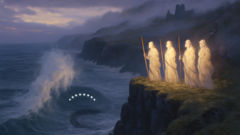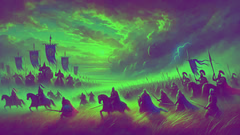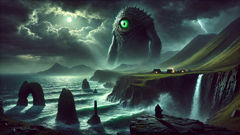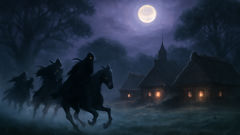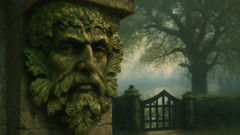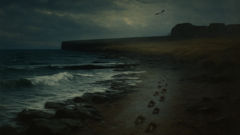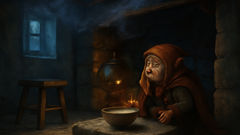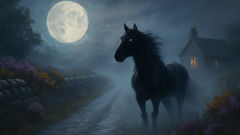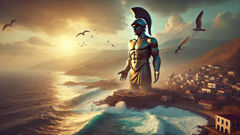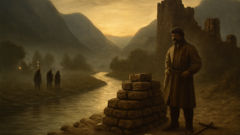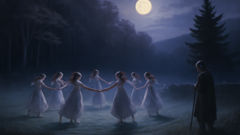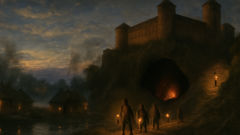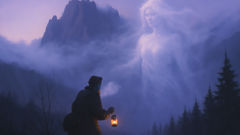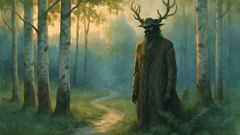Introduction
Long before the maps that men now consult, when the world’s edges were still disputed between storm and shore, the island we call Ireland hung like a green shard beneath the unkind sky. The air then tasted of salt and iron; the beaches were swept by currents that brought wreckage from distant lands and rumours from the deep. In that raw horizon lived a people the poets would later call the first gods—luminous craftsmen and fierce-hearted nobles whose power came from the earth, the wind, and the thin light of the north. But for every light there is a shadow, and out of the Atlantic’s furrowed breast rose the Fomorians: creatures of salt and storm, sea-giants whose limbs were knotted with barnacle and weed, whose eyes glowed like drowned lanterns, and whose voices carried the creak of timber and the groan of ancient ship-hulls. They were not a single race in the sense we use the word; they were an accretion of threats—spirits, mutated men, cyclopean rulers—bound together by hunger and a will older than the first hearth. They came in tides: sometimes in skiffs of black kelp and pitch, sometimes as towering silhouettes that made cliffs seem like the ridges of sleeping beasts. Their rulers—Balor, whose one eye burned like a thunder-stone; Conand and Cet mac Mágach, monstrous captains; and others whose names are half-sung and half-feared—took the sea as their court and the coasts as their playgrounds. The first gods, those who would bequeath Ireland its hills and songs, did not receive the intrusion meekly. They met the Fomorians not only with spear and blade but with cunning and craft: enchantments whispered into the roots of trees, laws forged from the bones of whales, and devices of silver and song that could snare a tide. Where the shoreline buckled, battles unfurled—skirmishes that tore up sand and surf, pitched wars in shadowed coves, and a war of attrition that would determine which voices shaped the island’s stories. This is a tale of that clash: of cunning and sacrifice, of monstrous appetite and bright resistance, of how the land itself was forced to choose a steward. It is a story of names that survive as place and echo, of scars on cliffs that remain and of legends that teach the living how to read the weather, the sea, and the human heart.
Origins and Nature of the Fomorians
The Fomorians were not born of a single cradle; their origins are braided from sea-mist, stolen children, and the older, darker powers that predated even the polite genealogies of gods. In the geological memory of the island there lies an older sea-language: storms that remember a time when the coastlines were different and the Atlantic reached deeper inland. From those memories the Fomorians took shape—half-formed wills that refused to be washed away. They are described in some accounts as descendants of the children of Cian and Balor, or as remnants of a pre-god, pre-human presence that stood as an argument against the new order of light. The most common image that survives in songs and the lip-words of old storytellers is the sea-giant: immense figures with torsos encrusted in shell and algae, hair braided with rope and driftwood, skin like the dark underbelly of a beached whale. Limbs ended in hooks or webbed hands capable of crushing hulls and stripping sails as easily as a man might pluck a string. Some Fomorians, the lore insists, were monstrous hybrids—one-eyed kings like Balor whose gaze could burn or kill, and others who bore the stench and shape of sea-animals. But to reduce them to mere physical horror is to miss the deeper truth: the Fomorians were a force, a pattern of appetite and resistance embodied in bodies that terrorized and enchanted in equal measure.
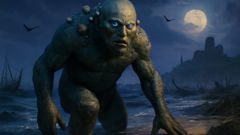
They were intimately tied to the sea’s rhythms; when the tide swelled and the moon was full, their voices could be heard in the squeal of rigging and the moan of cliffs. Communities near estuaries kept talismans and recited charms when the surf turned loud as drums. These protections are the bones of older rituals—offerings of fish, the binding of charms into nets, and the placement of standing stones carved with runes to confuse the eye of the Fomorian. The first gods respected some of these older rites, not because they feared inferiority, but because they recognized the ancient covenant between land and sea: that one might not own the other without incurring a penalty. Where the Fomorians demanded tribute, they demanded dominion: they wanted not only food but influence, the right to claim headlands and to demand the terms of passage along currents.
Leaders among the Fomorians were not always the largest or ugliest. There was cunning among them—rulers who preferred cunning to the simple cruelty of size. Balor, whose name still flickers like an ember in the mouths of singers, is a study in the peculiar fusion of power and fatal flaw. He is described as a one-eyed potentate whose burned eye could lay waste to armies; but even Balor’s preeminence required alliances with other monstrous houses. Conand, sometimes rendered as Conand mac Febail in later retellings, is a rapacious ruler whose raids were as merciless as the sea’s hunger. The Fomorians sustained themselves on a feast of disruption: raiding coastal settlements for slaves, imposing tax-like demands on the first gods’ outposts, and stealing the children of seafaring families to swell their numbers. Their society, if it can be called that, was a mosaic of war bands—sea-kin, storm-born thralls, colossal smiths who beat iron in submerged caverns, and singers who twisted curses into the bones of ships. Unlike the first gods who kept courts and cultivated craft, the Fomorians embodied a kind of living entropy: they reorganized a place by taking from it the very elements of life and reshaping them into trophies and fortresses. Yet even creatures of appetite need narratives, and the Fomorians told stories: of a mother sea that was jealous, of an age when the world below water breathed longer than the land. Those stories were warnings as much as justifications, and to the island that felt their teeth they were anathema—a reminder that any culture that stalked the shore must also contend with the sea’s claim.
The Early Wars: Tactics, Alliances, and Tragedy
When the first gods—the radiant folk who would later be named the Tuatha Dé Danann—began to settle the island, they encountered not a blank world but a contested one. The Fomorians had long claimed certain headlands and trenches, and their raids were not mere skirmishes but a sustained pressure on the island’s emerging order. The earliest confrontations were as much about resources as about prestige: the Fomorians wanted coastal salt springs and deep-sea trenches, while the gods sought farmland, clear rivers, and safe harbors for their ships. Battles took many shapes. Sometimes they were night raids, where Fomorian skiffs slipped in like shadow-gnats and carried off cattle and children before dawn. Other times the clashes were pitched at the mouths of rivers, where the Tuatha fought with bronze-sheathed spears and enchantment, their bodies surrounded by rings of silver charm that gleamed like fish-scales. The Fomorians used tactics honed to the sea: sudden surf-side assaults that wore down defenders, feigned retreats that lured pursuers into hidden reefs, and sorceries that turned fog into a curtain through which their archers could shoot with impunity.
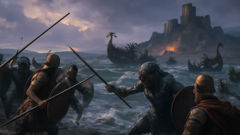
Alliances among the gods were not automatic; they were forged in the heat of necessity. Nuada Airgetlám—Nuada of the Silver Hand—became a symbol of resistance because he embodied the marriage of craft and will. After losing his arm in early encounters and having it replaced with a silver prosthetic wrought by skilled smiths, Nuada continued to command, and his presence gave shape to opposition. The formation of counsels—where druids, smiths, and warriors debated strategy—was an essential development. The gods also learned to harness the land itself against the sea. They erected barrows and cairns with runic stones designed to confuse the Fomorian sense of direction; they dug channels and shifted river mouths so that familiar currents would betray the invader. The Tuatha’s sorcerers learned to twist storms back toward their source; their healers devised salves that could knit salted wounds faster and create rents in enemy ships by making timbers rot from within. Yet victories were always costly. There were moments of bright triumph—raids where Fomorian commanders were slain and piles of neptune gold were salvaged—but each victory was paid for in lives and in the slow erosion of coastal villages. The Fomorians, for their part, adapted. Where brute force failed, they deployed cunning: agents who could mimic the voice of a fisherman, or who could cast illusions of child-cry to lure the compassionate to their doom. Children who were taken often returned changed, speaking in whispers and dreaming of submerged halls where light bent oddly and timbers grew like fingers. Sometimes the gods struck bargains: a coastal lord might be allowed to remain if he promised a tithe of fish and ship timbers, or if he offered the names of those who would sail against the Fomorians. Such bargains were fraught; they granted the Fomorians footholds and turned neighbors into collaborators. The war became as much a story of moral ambiguity as of military engagement. One of the most painful episodes occurred when a god-king, weary of loss, accepted a Fomorian hostage in exchange for peace. The hostage was a child of light, raised under the tide until his voice was salt-rough. When the truce broke, the gods slew the child to prevent its corruption spreading inland—an act that stained the hands of those leaders and haunted their descendants. Those tragedies multiplied, and with each atrocity the island’s songs grew darker.
As the conflict matured it acquired theaters beyond the sea. Battles were fought in mountain passes where Fomorian shamans would conjure mists to hide armies and cause avalanches of scree; in bogs where the earth itself would appear to swallow a party of ordinary men; and in caves where the Fomorians kept smiths who hammered iron in a rhythm that could seem like the sea itself breathing. Strategic ingenuity grew. The Tuatha developed weapons that could pierce the thick hides of some Fomorians—spear points laced with corrosive salts and arrowheads made from the fused teeth of sea-beasts. They also learned the politics of kinship: marrying into coastal clans to secure loyalties, and fostering the children of fisher-lords so that their hearts would lean landward. Prophecy played a role too. Seers, deep-eyed with the salt of many nights, spoke of a fate that required extraordinary sacrifice: that a leader born of mixed blood would bring the decisive edge. Such prophecies could be self-fulfilling; they shaped choices as much as they predicted them. When Nuada rose and when others answered the call, it was because choice and necessity had become indistinguishable. The wars blurred the line between heroism and cruelty, and in the smoky aftermath the island’s map was redrawn—headlands changed hands, small kingdoms were erased, and ancient ways of life were either buried under silt or adapted to a world where the sea’s teeth could appear at any time.
Turning Points: Balor, Betrayal, and a New Order
No single tale captures the turning tide of the wars as clearly as those focusing on Balor of the Evil Eye and the eventual cunning that felled him. Balor’s myth is emblematic—he was a force as much as a man, a lord whose destructive gaze could fell opponents like a lightning-struck tree. Many songs dwell on his one eye, telling how his mother tried to keep him sealed away because of a prophecy that he would be slain by his own kin. But prophecies are restless things; they move through households and cross thresholds in ways their originators cannot control. When the Tuatha and their allies conceived the plan to overthrow Balor, it was not merely arms they deployed but a web of guile that used Balor’s own arrogance against him.
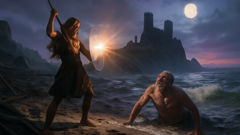
The key to the plan involved a union that was as political as it was fateful. Lugh, son of Cian—himself descended from semi-divine lines—arrived on the island as an itinerant master of many crafts, a boy who carried a spear and the confidence of one who could master any craft he touched. His destiny entwined with that of Balor when Lugh’s presence at court proved too luminous to ignore. A marriage was arranged, as marriages among gods often are, and from that union arose an heir who would embody the island’s divided nature. The story differs by region: in some retellings Lugh is the son-in-law who enters Balor’s heart as guest or kinsman, in others he is a foster-child whose training prepares him to unharden the tyrant’s resolve. Regardless, when the decisive moment came, the Tuatha used weapons that fused magic and metal—spear shafts wrapped in the sinews of the land, points sharpened with tales told by druids to cut not only flesh but destiny. The battle that ended Balor is described as sudden and terrible: his eye unleashed its ruinous beam, scorching men and turning boats into smoking husks, but it was diverted by a mirror-shield, an act of quick wit that sent the burning eye back upon its master. Balor’s fall was as violent as his rule. His collapse altered the Fomorian confederation; some of their leaders were slain, others fled, and many remained as broken houses that would be picked apart by the victors.
Victory did not mean peace. The island’s politics were reconfigured in ways that bore new injustices. The Tuatha’s triumph enabled them to claim many headlands and to legislate new rights on the coasts, but it also created new strains of resentment. Some coastal lords who had collaborated with Fomorian captains in order to survive were punished harshly, losing lands and bloodline standing. Others adapted and were absorbed into the new order, their customs and dialects gradually transformed by court etiquette and law. The Fomorians who survived the fall of their major leaders retreated deeper into submerged realms, into caves and undersea halls where light did not reach as readily. Many of their descendants, the storytellers say, are the restless spirits that sometimes walk the strand still—murmuring, bargaining, haunting. Cultural memory kept them alive: place-names became living reminders of battles and bargains, such as the “Strand of the Monstrous Tide” or coves named for the Fomorian captains who once ruled them. But the transformation was not absolute; the Tuatha had learned from their adversaries. The use of tidal knowledge, seawards charms, and oaths regarding hostages were new tools in their governance. The island, in consequence, became a hybrid political ecology—an interior granted a kind of supremacy, and a border along the sea that had to be managed with both force and diplomacy.
The mythic closure of the wars does not present itself as an ending so much as a reordering. The Fomorians ceased to be the unchallenged masters of certain coasts but persisted in other forms—some becoming local deities bound to coves, some transformed into monstrous names carved into rock, and some integrated as half-remembered gods who taught smithing and the secrets of tides. The Tuatha, on their side, found their influence tempered by the need to protect blue borders. They established new rituals—days of appeasement when salt was left on headlands, and rites to welcome the first seasonal fish—as reminders that the sea’s claim was never fully eraseable. Stories grew into poetry and law; songs turned into genealogies that legitimized rule. Yet in the hush between wind and water the old warnings still breathe. The history of the conflict became a lesson preserved in the cadence of lullabies and the stone circles that cast long shadows at dusk: power won through violence will always require vigilance, and any order that ignores the restless depth will inherit a new, subtler fury. In the end, the island learned to listen—its people learned to read the sea and to offer it both gifts and defiance, for the Fomorians remained a part of the landscape as much as the cliffs and bogs: a reminder that the tides of memory and appetite go on, and that every shore is a negotiated place.
Conclusion
The myth of the Fomorians endures because it speaks to continuities we recognize: the struggle between order and chaos, the necessary compromise between land and sea, and the moral ache left by bargains made during desperate times. These tales live in place-names, in the rituals of fishermen who toss a coin toward the waves before launch, and in the songs parents croon to steady children when the wind sharpens. They instruct as much as they warn: that survival often demands cunning, that victory carries a cost, and that the old and dark are never wholly gone—they can be negotiated with, appeased, or transformed. Ireland’s shores still hold traces of these negotiations. Stones worn with the marks of blades and the initials of long-ago kin point to battles beneath salt-scarred skies; wells near coves are said to have been dug to bury charms that confuse the sea’s gaze; and storytellers still whisper of encounters in which the tide calls a name, and an old voice answers from beneath. The Fomorians, therefore, remain more than monsters; they are an account book of the island’s primal bargains, kept where the water laps and the wind remembers. To read the myth clearly is to recognize a landscape that refuses simple ownership, a culture that learned to shape itself against the roar of the deep, and a set of stories that teach how to live on a place that is both harvest and hazard. These are lessons that stay with us: to respect the limits of dominion, to remember that every triumph leaves behind a ledger of loss, and to honor the fragile truces that allow human life to flourish at the edge of an ungovernable sea.

